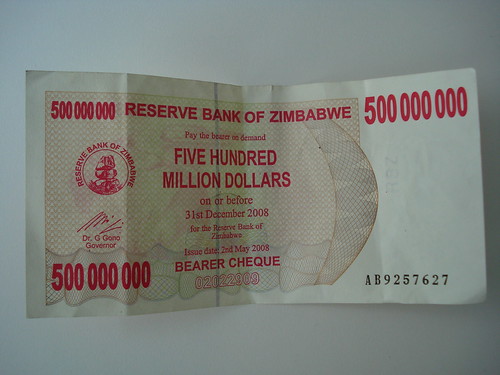Overview of Zimbabwe’s Currency History
Zimbabwe’s currency history is marked by periods of significant inflation and monetary instability, reflecting the economic challenges faced by the country over the years. From the introduction of the Zimbabwean dollar to the hyperinflation crisis that led to the issuance of increasingly large denominations, the nation’s monetary system has undergone remarkable changes. Understanding this history provides essential context for the conversion of the infamous 10 trillion Zimbabwean dollars into US dollars, highlighting the impact of economic fluctuations on currency value.
Hyperinflation and Its Causes
Zimbabwe’s currency history has been marked by periods of severe instability, hyperinflation, and monetary reforms. In the late 20th and early 21st centuries, Zimbabwe experienced one of the most extreme cases of hyperinflation recorded globally, which significantly impacted its currency system and economy.
The hyperinflation was primarily caused by a combination of economic mismanagement, excessive money printing to finance government deficits, declining agricultural productivity, and loss of confidence in the monetary system. This led to the rapid devaluation of the Zimbabwean dollar, reaching astronomical levels.
During the peak of hyperinflation, Zimbabwe introduced increasingly larger denominations of banknotes, culminating in the infamous 100 trillion Zimbabwe dollar note. At its height, hyperinflation was estimated at 79.6 billion percent month-on-month in November 2008, rendering the currency virtually worthless.
In the context of hyperinflation, the value of 10 trillion Zimbabwe dollars became negligible in terms of real-world worth. It often required millions or billions of Zimbabwean dollars to purchase basic goods, illustrating the devastating effects of uncontrolled inflation on daily life and savings.
To address the crisis, Zimbabwe eventually abandoned its own currency in 2009 and adopted foreign currencies such as the US dollar and South African rand. This move stabilized the economy and restored some confidence in the monetary system. Today, Zimbabwe has a multi-currency system and is working toward reintroducing a new Zimbabwean dollar under prudent policies.
- Extreme Hyperinflation in Zimbabwe led to the issuance of 100 trillion dollar notes.
- The cause was primarily excessive money printing and economic mismanagement.
- Hyperinflation peaked at nearly 80 billion percent per month in late 2008.
- The hyperinflation rendered the Zimbabwean dollar practically worthless.
- Zimbabwe adopted foreign currencies in 2009 to stabilize the economy.
- Today, efforts continue to restore a stable and functional national currency.
Introduction of the 10 Trillion Zimbabwe Dollar
The Zimbabwean currency history is marked by periods of hyperinflation, which led to the rapid devaluation of the local dollar. In response to economic instability, the Reserve Bank of Zimbabwe introduced a series of new banknotes over the years, culminating in the issuance of the infamous 10 trillion Zimbabwe dollar note. This denomination was introduced in 2008 during the height of hyperinflation, reaching unprecedented levels of inflation that rendered the currency almost worthless domestically.
The 10 trillion Zimbabwe dollar banknote became a symbol of the extreme economic challenges faced by the country, with hyperinflation rates soaring into billions and trillions of percent. Despite the impressively large denomination, the note held negligible value on the black market and internationally. Eventually, Zimbabwe abandoned its own currency in favor of foreign currencies such as the US dollar and South African rand to stabilize the economy. Consequently, converting the 10 trillion Zimbabwe dollar to US dollars reveals its devalued status, often equating to mere cents or fractions of a dollar, highlighting the severe inflationary spiral Zimbabwe experienced during this period.

Understanding the Exchange Rate
Understanding the exchange rate is essential when comparing the value of currencies from different countries. It determines how much of one currency can be exchanged for another and is influenced by various economic factors. In the context of Zimbabwe’s hyperinflation, converting large amounts like 10 trillion Zimbabwe dollars to US dollars highlights the significance of exchange rates in assessing the actual worth of money across borders.
Historical Context of USD-Zimbabwe Exchange Rate
The exchange rate between the Zimbabwean dollar and the US dollar has experienced significant fluctuations over time, reflecting the country’s economic challenges and hyperinflation periods. Historically, Zimbabwe faced soaring inflation rates in the late 2000s, peaking with hyperinflation that rendered the local currency practically worthless. During this period, the government issued high denomination banknotes, including a 10 trillion Zimbabwe dollar note, to cope with rapid price increases. This hyperinflation eroded the value of the Zimbabwean dollar to the point where exchange rates became highly unstable, with the official rate often diverging sharply from the market rate. As a result, converting large sums like 10 trillion Zimbabwean dollars into US dollars required understanding the historical context of inflation and currency devaluation. Eventually, Zimbabwe abandoned its own currency in favor of foreign currencies, including the US dollar, to stabilize the economy and restore trust in its monetary system. Today, the historical exchange rate highlights the severe economic disruptions Zimbabwe experienced and underscores the importance of stability in foreign exchange markets.”
Value of 10 Trillion Zimbabwe Dollars in USD
Understanding the exchange rate is crucial when converting the value of money from one currency to another. In the case of 10 trillion Zimbabwe dollars, the actual value in US dollars depends heavily on the current exchange rate between the Zimbabwean dollar and the US dollar. Due to hyperinflation and economic instability in Zimbabwe over recent years, the Zimbabwe dollar has experienced significant devaluation, resulting in a very low value relative to major currencies like the US dollar. As a result, 10 trillion Zimbabwe dollars may only be worth a few US dollars or even less, depending on the latest official or black market rates. To accurately determine the USD equivalent, one must consult up-to-date exchange rates, which are often subject to rapid fluctuations in cases of unstable economies.”
Estimating the Conversion
Estimating the conversion rate between different currencies is essential for understanding their relative value and making informed financial decisions. When dealing with significant figures, such as 10 trillion Zimbabwe dollars, it becomes even more important to accurately assess its worth in US dollars. This process involves analyzing current exchange rates, economic conditions, and historical data to determine the most precise conversion estimate. Such calculations help individuals and businesses navigate international transactions and economic comparisons effectively.
Official Figures at the Height of Hyperinflation
During periods of hyperinflation, estimating the conversion rate between the local currency and US dollars becomes exceedingly challenging due to the rapid devaluation of the currency. In Zimbabwe’s hyperinflation era, especially when the currency reached denominations like 10 trillion Zimbabwe dollars, official figures often lagged behind actual market values, leading to significant discrepancies.
Official figures at the height of hyperinflation typically provided a nominal exchange rate, but these were frequently outdated or manipulated, failing to reflect real market conditions. To accurately estimate the value of 10 trillion Zimbabwe dollars in US dollars, analysts often relied on parallel market rates, black market data, or adjusted official rates considering inflationary trends and economic indicators.
During Zimbabwe’s hyperinflation, the true worth of such currency amounts was essentially evaporated, requiring conversions based on recent market transactions rather than official rates. By evaluating the black market exchange rate at the time—often thousands or millions of Zimbabwe dollars to one US dollar—one could approximate that 10 trillion Zimbabwe dollars was equivalent to only a few US dollars, highlighting the devastating impact of hyperinflation on currency value.
Market-Based and Black Market Exchange Rates
Estimating the conversion rate from Zimbabwean dollars to US dollars involves examining both market-based and black market exchange rates due to the country’s economic instability. The official market rate often reflects government-set figures, which may not represent real-world transactions. In contrast, the black market rate provides a more accurate estimate of the currency’s actual value in informal or unregulated markets. For instance, when converting 10 trillion Zimbabwean dollars to US dollars, the official rate might suggest a certain amount, but the black market rate could indicate a significantly different, often much lower, value. This disparity highlights the importance of considering both rates to obtain a comprehensive understanding of the currency’s worth in various contexts.
Impact of Hyperinflation on Currency Value
Hyperinflation has a profound effect on the value of a nation’s currency, often leading to drastic declines in its purchasing power. In cases like Zimbabwe, where hyperinflation spiked to extraordinary levels, the local currency became almost worthless, requiring astronomical amounts for basic transactions. This article explores the impact of hyperinflation on Zimbabwe’s currency, specifically examining the exchange rate of 10 trillion Zimbabwe dollars to US dollars and what it reveals about economic instability and the devaluation of the local currency.
Devaluation of Zimbabwe Dollars
The impact of hyperinflation on currency value is profound, often leading to rapid devaluation and extreme instability. In Zimbabwe, hyperinflation during the late 2000s drastically reduced the worth of the Zimbabwean dollar, causing severe economic disruption. One notable example is the denomination of 10 trillion Zimbabwe dollars, which ultimately became nearly worthless in terms of purchasing power when exchanged for stable currencies like the US dollar.
- Hyperinflation erodes the real value of the currency, making prices skyrocket rapidly.
- People lose confidence in the national currency, resorting to foreign currencies for transactions.
- Excessive printing of money to cover government deficits leads to an inflationary spiral.
- The value of savings diminishes significantly, threatening individual financial security.
- Business uncertainty increases as prices fluctuate unpredictably.
- Denominations skyrocket, with bills like 10 trillion Zimbabwe dollars becoming symbolic of economic collapse.
When converting 10 trillion Zimbabwe dollars into US dollars, the amount received is minimal due to hyperinflation’s devaluation effects. This example underscores how hyperinflation diminishes a currency’s value, ultimately rendering it almost useless for practical transactions and emphasizing the importance of stable economic policies to maintain currency stability.
Comparison of Nominal vs. Real Value in USD
The impact of hyperinflation on currency value is profound, often rendering the local currency nearly worthless in terms of international exchange. During periods of hyperinflation, such as in Zimbabwe, the nominal value of the currency skyrockets, exemplified by the infamous 10 trillion Zimbabwe dollars which had little to no real purchasing power abroad. Comparing nominal versus real value highlights that while nominal figures might suggest enormous sums, these numbers do not account for the diminishing value of money over time. The real value adjusts for inflation, offering a clearer picture of the actual purchasing power of money. In hyperinflationary scenarios, the nominal value becomes deceptive, as the real value plummets, making the currency practically useless for everyday transactions and drastically reducing its international convertibility to stable currencies like the US dollar. Consequently, hyperinflation erodes confidence in the local currency, prompting citizens and investors to seek more stable alternatives, often leading to dollarization or the use of foreign currencies for transactions.
Practical Implications for Holders of Zimbabwe Dollars
Holders of Zimbabwe dollars face significant practical implications due to the country’s ongoing economic challenges and currency devaluations. With the recent conversion rate of 10 trillion Zimbabwe dollars to US dollars, individuals and businesses need to understand how these changes impact their savings, transactions, and financial planning. Navigating this currency shift requires awareness of local monetary policies and the broader economic context affecting the value of Zimbabwe’s currency.
Converting Large Sums into USD
Converting large sums such as 10 trillion Zimbabwe dollars into USD has significant practical implications for holders. Given the extreme inflation and devaluation of the Zimbabwe dollar, converting substantial amounts can help preserve value and mitigate risks associated with local currency fluctuations. It is advisable for holders to seek professional financial advice and utilize reliable foreign exchange services to ensure transparency and maximize conversion rates.
Additionally, the process of converting large sums may involve regulatory considerations, such as compliance with currency control laws and potential documentation requirements. It’s essential to stay informed about applicable policies and work closely with authorized financial institutions to facilitate smooth transactions. Converting to USD can provide stability and easier access to international markets, but holders should be aware of potential transfer costs and exchange rate volatility.
Lastly, holding USD rather than Zimbabwe dollars can offer long-term security and income preservation, especially in a country facing economic instability. However, individuals should consider the timing of transactions to capitalize on favorable exchange rates and minimize losses. Overall, prudent planning and informed decision-making are crucial for effectively managing large currency conversions in Zimbabwe’s economic context.
Financial and Economic Consequences
The value of 10 trillion Zimbabwe dollars in US dollars highlights the severe inflationary challenges faced by Zimbabwe, leading to drastic devaluation of the currency. For holders of Zimbabwe dollars, this situation results in substantial loss of purchasing power and erodes savings, rendering their holdings almost worthless in real terms. Financially, individuals and businesses may struggle to maintain liquidity, forcing them to adopt alternative means of transaction such as foreign currencies or barter, which complicates economic stability. Economically, this hyperinflation discourages investment, hampers growth, and increases uncertainty across markets, potentially precipitating a recession. The reliance on foreign currencies becomes essential for transactions, undermining the credibility of the local currency and posing long-term issues for national monetary policy and economic sovereignty.
Current Status of Zimbabwe’s Currency
The current status of Zimbabwe’s currency reflects significant economic challenges, marked by ongoing hyperinflation and a rapidly declining value of the local dollar. As the nation grapples with inflationary pressures, the exchange rate between Zimbabwean dollars and major international currencies like the US dollar has become a critical issue. Recently, the exchange rate has soared to the equivalent of 10 trillion Zimbabwean dollars to one US dollar, highlighting the severe devaluation and the complexities facing Zimbabwe’s monetary system. This situation underscores the need for economic reforms and stabilization efforts to restore confidence and reliability in the country’s currency.

Reforms and New Currency Introductions
The current currency situation in Zimbabwe has been marked by significant reforms and the introduction of new monetary measures aimed at stabilizing the economy. Over the years, the country has experienced hyperinflation, which led to the issuance of increasingly higher denominations, culminating in the infamous 10 trillion Zimbabwean dollar banknote. This hyperinflation rendered the currency virtually worthless and prompted the government to take corrective actions.
In recent years, Zimbabwe has undertaken monetary reforms to restore confidence and stability. The country reintroduced the Zimbabwean dollar as the official currency in 2019 after years of using foreign currencies such as the US dollar and South African rand. These reforms included dollar redenominations and the implementation of policies to curb inflation. Despite these efforts, inflation remains a concern, and the exchange rate fluctuates significantly.
The exchange rate of 10 trillion Zimbabwe dollars to US dollars underscores the extent of hyperinflation experienced in the past. Today, these hyperinflation-era notes have become collectors’ items rather than circulating currency. The government continues to work towards monetary stability through a combination of monetary policy adjustments, forex regulations, and efforts to rebuild the country’s financial infrastructure.
Total stabilization has yet to be achieved, but ongoing reforms are aimed at fostering economic growth and restoring the value of Zimbabwe’s currency. The journey from hyperinflation to a more stable currency system remains ongoing, with the recent history of currency denominations serving as a reminder of the challenges faced and the resilience of Zimbabwe’s economic reforms.
Lessons Learned from the Hyperinflation Era
The current status of Zimbabwe’s currency reflects significant stabilization efforts following a turbulent hyperinflation era. Amidst ongoing economic reforms, the Zimbabwean dollar has experienced periods of recovery, but challenges remain regarding monetary stability and confidence. A notable instance illustrating the severity of past inflation was the exchange rate involving 10 trillion Zimbabwean dollars to US dollars, highlighting the extent of hyperinflation and the need for systemic reforms.
Lessons learned from Zimbabwe’s hyperinflation era underscore the importance of prudent monetary policy and economic discipline. Key insights include:
- Hyperinflation can erode savings and wealth, leading to economic collapse.
- Maintaining credible monetary policy and currency stability is essential for economic health.
- Trust in the national currency is crucial; without it, currency becomes worthless regardless of nominal denomination.
- Dollarization or adopting foreign currencies can offer temporary stability but may hinder monetary sovereignty.
- Implementing sound fiscal policies and avoiding excessive money printing are fundamental to preventing hyperinflation.
- Transparent communication and strong institutions build confidence among citizens and investors.
- Economic diversification can reduce dependence on unstable sectors and stabilize inflation.
- Exchange rate stabilization is vital for fostering international trade and investor confidence.
- Recovery from hyperinflation is gradual and requires consistent policy measures over time.
- Historical lessons emphasize the need for proactive measures before inflation spirals out of control.





0 Comments